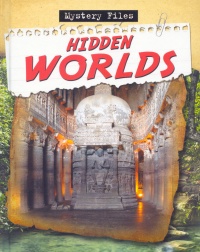| ________________
CM . . .
. Volume XIX Number 29. . . .March 29, 2013
excerpt:
One of eight books in the “Mystery Files” series, Hidden Worlds gives the reader an introductory overview to some of the hidden mysteries that have been found, both natural and man-made. Examples of the natural items described are the cenotes or fresh water sinkhole caves of the Yucatan Peninsula and the molten, not hollow, center of the earth. People long ago believed the center of the earth held another world. The scientific proof that it doesn’t is cited. The man-made anomalies include the moai statues on Easter Island which were erected to honor the residents’ ancestors. Imagine building a monastery on a mountain only accessible by climbing a cliff or living in homes in caves on the side of a cliff. The secret tunnels used by the Viet Cong during the Vietnam War and the cave temples in India are also described. Lost pyramids and terra cotta warriors have been unearthed in China, and ghost towns in Nevada stand silently as reminders of past prosperity in those areas. Even now in modern times, people in the Australian town of Coober Pedy live in homes hidden underground in order to avoid the extreme heat of the desert. Each anecdote is featured on a double-page spread with captioned, colorful photographs and a simple explanation of the mystery. The book is designed as if it were a scrapbook owned perhaps by a scientist or explorer in the field. Extra tidbits of information are found in a circle labeled ‘Mystery File’. Some examples of these are Poison Pills, Rock Building and Human Sacrifice. Mystery words are explained at the bottom of each article as well as in the glossary at the back of the book. There, the reader will also find an index and a page called ‘Find Out More’. Books and websites listed would provide more details about some of the topics. The information in this book caters to young people who are interested in life from the past. The places featured are all still open to anyone interested in visiting and exploring them further. The text is written simply enough for younger readers, but the place names will require more capable reading skills. However, readers need not be deterred by difficult place names because the pictures are quite compelling. Readers both young and old will be intrigued by this informative book. Hidden Worlds is recommended for any elementary or middle year’s school library. Highly Recommended. Sherry Faller, a retired teacher-librarian, lives in Winnipeg, MB.
To comment
on this title or this review, send mail to cm@umanitoba.ca.
Copyright © the Manitoba Library Association. Reproduction for personal
use is permitted only if this copyright notice is maintained. Any
other reproduction is prohibited without permission.
NEXT REVIEW |
TABLE OF CONTENTS FOR THIS ISSUE
- March 29, 2013.
AUTHORS |
TITLES |
MEDIA REVIEWS |
PROFILES |
BACK ISSUES |
SEARCH |
CMARCHIVE |
HOME |
